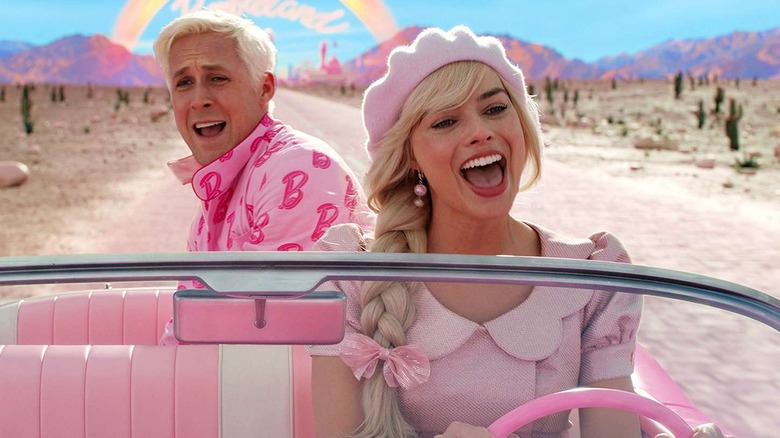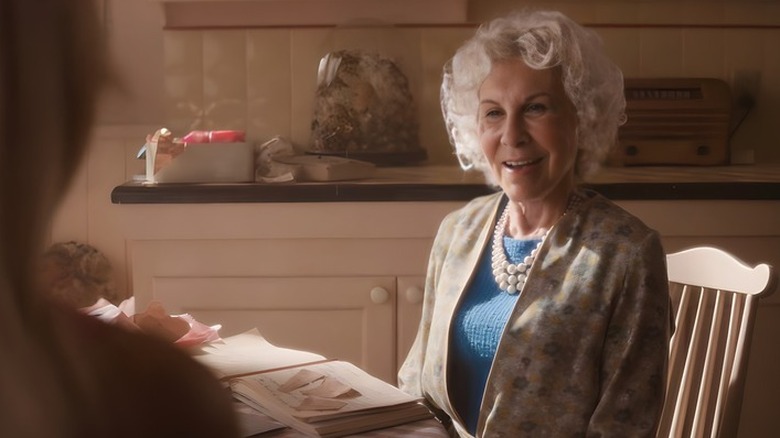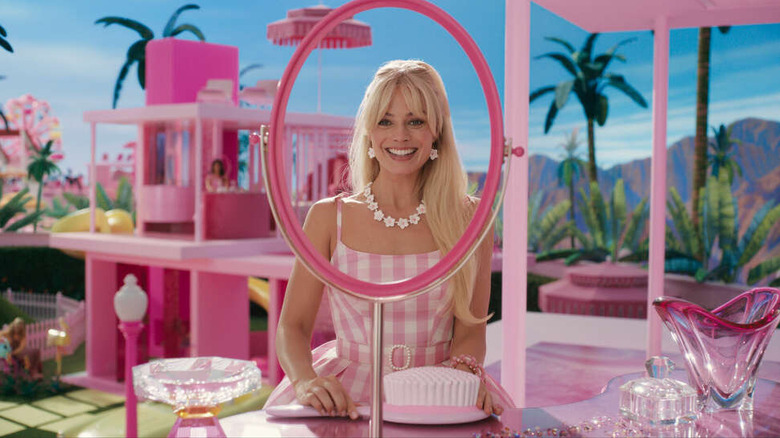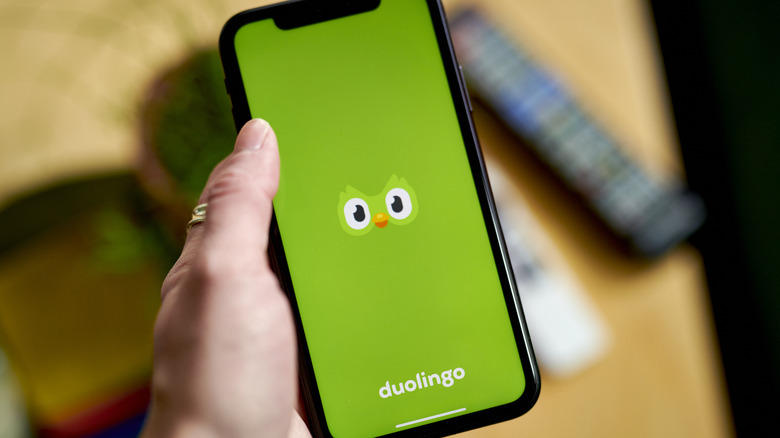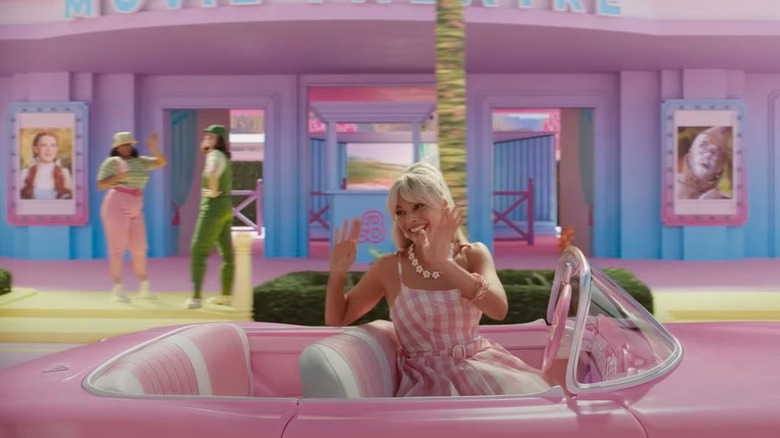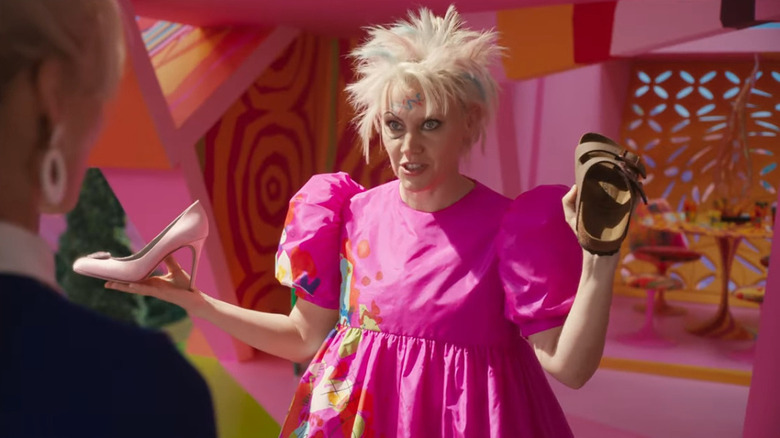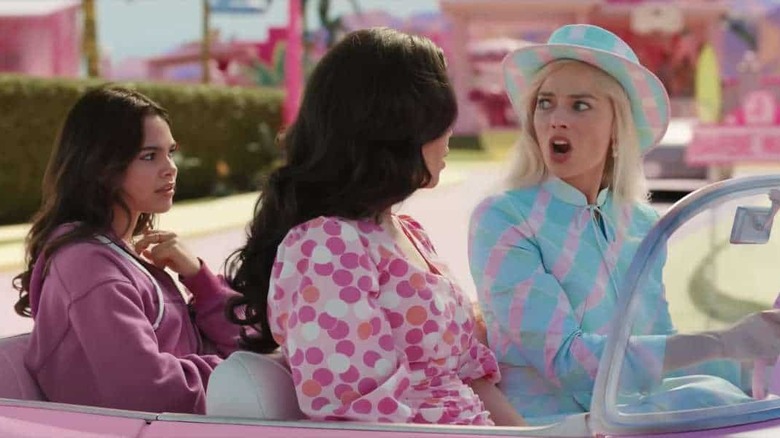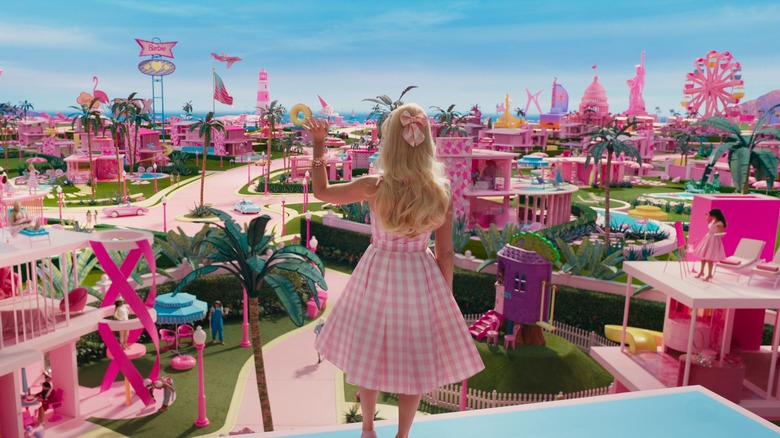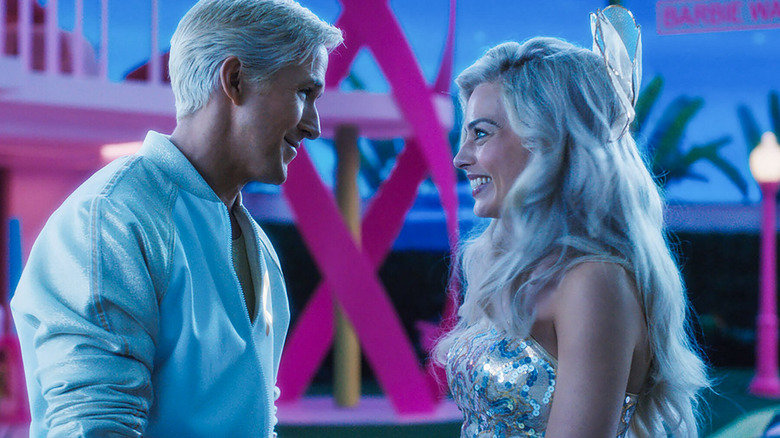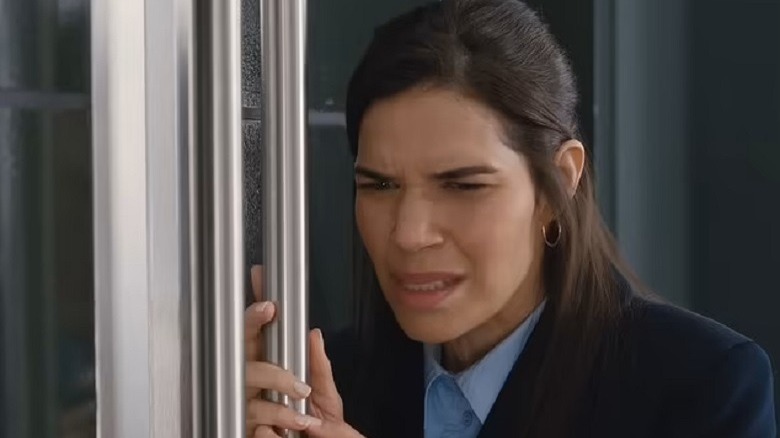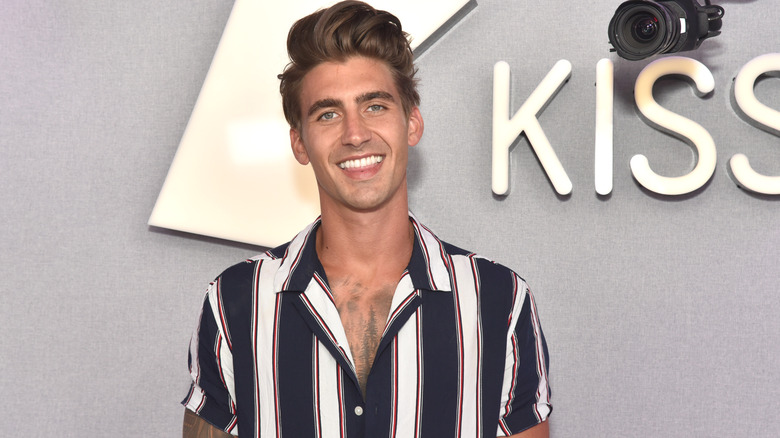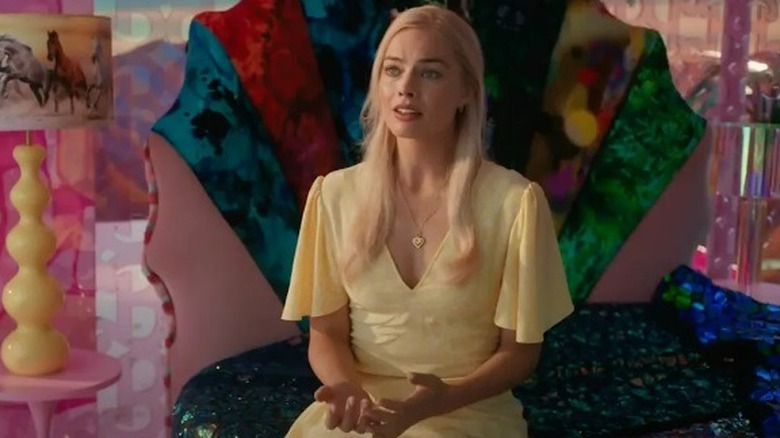Things You Only Notice In Barbie After A Second Watch
Given that "Barbie" earned over $1 billion at the worldwide box office, it's pretty safe to assume that at least some of that business has come from repeat viewings. And it's exactly the kind of movie that people would want to see multiple times — light, funny, and extremely uplifting. Fortunately, director Greta Gerwig and her co-writer Noah Baumbach ensured that it would reward a re-watch as it is packed with tons of fun little details, background gags, and Easter eggs that are easy to miss on the first viewing, considering that there's so much else filling the frame at any given moment — and that it's hard to take our eyes off of Margot Robbie and Ryan Gosling any time they are on screen.
But it's not just the chance to see a funny sign or blink-and-you'll-miss-it cameo that makes "Barbie" special on a second viewing. There are things that occur early in the film that have more context once you know where everything is going, and it makes those moments mean something extra when you see them again. Here are just a few moments that viewers will appreciate even more upon a second watch.
Ruth's true identity is hinted at in her first scene
By the end of the movie, it is definitively spelled out that the mysterious elderly woman that Rhea Perlman plays is in fact meant to be Ruth Handler — the real-life co-founder of Mattel and the creator of the Barbie doll. There is a funny scene where she makes several self-referential cracks to various facts about the real Ruth Handler, including Handler's tax evasion troubles in the late 1970s.
When we first meet the woman, she is in a room that looks like a 1950s-era kitchen, located behind a nondescript door in Mattel's headquarters. Barbie has a brief interaction with her before escaping through a nearby door, and we don't see the woman again until the end of the film. However, once you know it's supposed to be Ruth, it's much easier to pick up on the various hints that indicate who she is — such as the fact that she seems to be cutting and arranging fabric on the table as if designing doll clothes, and the pink gingham print of her table cloth that mirrors an iconic Barbie dress (and one that the movie Barbie wore earlier in the film). Ruth also never asks Barbie who she is and already seems to be familiar with her, speaking to Barbie with the kind of warmth and familiarity that a mother or grandmother would have.
Barbie's milk clearly says it's spoiled before she drinks it
On the second day that we see Barbie go through her morning routine in Barbieland, everything is all wrong. She burns her waffle, her (invisible) shower water is cold, and she plummets to the street from the roof of her dream house rather than gently floating to the ground. There's also the matter of her breakfast beverage, which — even though it's imaginary — has apparently gone bad, something that Barbie doesn't notice until she takes her first pantomimed sip.
At this point, she picks up the carton of milk and sees that the word "Spoiled!" is clearly printed across the front, in red lettering. However, once you know to look for it, you can see that the carton already says as much when it's sitting on the table, even before she picks it up, pours it, and takes her first taste. It's fun to notice it the second time before Barbie herself does, which makes the joke last even longer as a result.
Showing Gloria's husband doing Duolingo makes more sense
By now, everyone knows that Gloria's husband is played by America Ferrera's real-life husband, Ryan Piers Williams. Williams is an actor as well as a filmmaker, and Ferrera stars in several of his movies — including "The Dry Land" (2010) and "X/Y" (2014). It's also common knowledge at this point, even to those who didn't pick up on it at the time, that her husband saying "¡Sí, se puede!" is a nod to Ferrera's 2002 Disney movie "Gotta Kick It Up!" and the catchphrase her character says in the film.
All that being said, what isn't as deeply appreciated until a second watch is a brief scene in which we see Gloria's husband using the Duolingo language learning app earlier in the film to work on his Spanish. On a first pass, it just seems like a quick little throwaway gag, seeing him struggle to get the app to acknowledge his pronunciation and then being rewarded with the signature ding that millions of Duolingo users know all too well. But it pays off so much more when we know that his one big line in the movie is in Spanish, as if he's spent the entire time that Gloria and Sasha are running around in Barbieland preparing for his five seconds in the spotlight.
Background gags are easier to spot the second time around
There is a lot happening in "Barbie," just in terms of what the audience is supposed to be focusing on. The attention to detail in the film, particularly in the Barbieland scenes, is nothing short of astounding, and it speaks to Greta Gerwig and her crew's obvious affection for these characters, their world, and their history. Everyone who saw this movie knew that they were going to have to remain sharp-eyed at all times to catch the Easter eggs flying by at all times.
But with a genuinely fun movie happening in the foreground — and a lot of attractive people to keep an eye on — there's no way that anyone caught everything on the first viewing. One of the best things about watching it a second time is that you're a little freer to really hone in on everything that is going on in the periphery of any given scene. Things like the movie theater in Barbieland showing "Wizard of Oz" — a movie referenced multiple times throughout the film — to the "Barbiedales" store, to BAX airport, to the Warner Bros. Discovery building that can be seen near Mattel headquarters in the real world, the list goes on and on. Don't be surprised if you don't even catch everything on your second viewing.
Barbie choosing the Birkenstocks isn't just metaphorical
Kate McKinnon's Weird Barbie steals every scene she's in with her performance alone, but the character also gets to feature in several of the movie's most pivotal moments. The first involves Barbie coming to her for advice when she starts to experience her existential crisis. Weird Barbie explains to her that whoever is playing with her in the real world is clearly going through something dark and heavy, and so Barbie needs to go and find her to make things right.
Well, she gives Stereotypical Barbie a choice — either go and fix it, or pretend everything is fine and hope her problems just go away. This choice is presented to her in a hilarious homage to the red pill vs. blue pill scene from "The Matrix," only the options, in this case, are represented by either a pink high-heeled shoe or a Birkenstock sandal. On first viewing, it just seems like a funny way to represent the two worlds, but the ending gives it all a whole new context. When Barbie finally does choose to become a human woman and we see her in the real world in the final scene, she's wearing a pair of Birkenstocks — which means the choice that was previously offered to her was a much more literal one that we realized at the time.
Having more context for Sasha representing Bratz dolls
Only a few especially perceptive viewers noticed it initially, but it soon became one of the most talked-about references once "Barbie" was finally released to theaters — the fact that Gloria's daughter, Sasha, was meant as a tribute to the Bratz line of dolls. Created, appropriately enough, by a former Mattel employee, Bratz dolls were first released in 2001 and were meant to be younger, hipper, edgier, and more diverse dolls for girls who saw Barbie as outdated. And one of them was named Sasha.
Sure, Sasha isn't exactly an uncommon name, so it was easy to chalk this up to coincidence or people reaching a little too hard to find Easter eggs that weren't there. But the clues add up once you know to look for them. When both the audience and Barbie first meet Sasha, she's sitting at her school lunch table with three of her friends. It just so happens that the Bratz line launched with three other dolls, and while Sasha's friends in the movie aren't named, they bear more than a passing resemblance to the other three main Bratz dolls — Yasmin, Cloe, and Jade. The connection seems all but confirmed when Gloria's mom calls Sasha "Bunny Boo" at one point, which is a nickname for the Sasha doll as well as the name of her pet rabbit.
Paying more attention to Lizzo's narration song
After the hilarious opening that pays homage to "2001: A Space Odyssey" as it briefly summarizes the history and creation of the Barbie doll, the movie then takes us to Barbieland and introduces us to its citizens. Those scenes are accompanied by a Lizzo song that plays as Barbie goes about her morning routine and then greets all the other Barbies, interspersed with narration by Helen Mirren.
When Barbie is having a bad morning on the second day that we see her, it starts to become a little more apparent that the lyrics in Lizzo's song are directly addressing the things that are happening to Barbie. It makes you wonder if the song had been doing that from the beginning — and when you watch the movie again, you see that, in fact, it was. With that knowledge, you can pay more attention to the lyrics of the song and how they match what is happening on-screen, and appreciate the extra layer that was added to that first scene, making it even more charming than it already was.
Some of Ken's stuff is still in Barbie's house after Barbieland is saved
When the Kens take over Barbieland and turn it into Kendom, the most drastic change we see is that of Barbie's dream house. It has been usurped by Beach Ken (Gosling), and he has now taken to referring to it as his Mojo Dojo Casa House — which Gloria and Sasha are quick to point out translates to him calling it his "house house." Ken has turned it into what he perceives as the ultimate bachelor pad based on what he learned about being a man from the real world, which equates to a lot of cowboy and horse décor.
At the end of the movie, when the Barbies have reclaimed Barbieland, they didn't completely return it to its previous state. Instead, they allowed the Kens to have more of a presence, making things a bit more balanced than they were in either of the two previous iterations of the world. To hammer that point home, an easy-to-miss detail is that Ken's saloon-like sign is still hanging on the front door of Barbie's dream house, indicating that there is now a place for him there, and that he is always welcome.
Gloria's drawings foreshadow her role in Barbie's crisis
It doesn't take Barbie long to make a spiritual connection with her owner in the real world, and to pinpoint exactly where she is. It's one of the many ways that the movie asks us to suspend our disbelief and doesn't waste too much time in explaining all the magical elements that power the plot, and it's all the better for it — we don't need to know exactly how Barbieland exists in the first place or why it's so easy to go back and forth between the two. Just accept it and have fun.
Once Barbie meets Sasha and sees that she's an angry, disaffected teenager, it's easy to just take that at face value to explain why Barbie has gotten so weird in her world. But the movie does briefly hint at the fact that it's actually Gloria who is at the root of the problem long before the movie officially reveals that. When we first meet her at Mattel headquarters, she shows her colleague some drawings she'd been working on. And they are twisted versions of Barbie she came up with, each one mirroring one of the crises that Barbie had been going through — Existential Crisis Barbie, Cellulite Barbie, and so on. Some of the audience may have picked up on it right away, but it still becomes an "a-ha" moment when you see it the second time.
Knowing the cameos and where to look for them
In addition to being able to notice more Easter eggs the second time around, it's also a lot easier to spot the cameos in "Barbie" on a second viewing. Whether it's because you were still trying to piece together who the person was, or you simply missed a cameo entirely until you heard about it after seeing the movie, the cameos are a lot more entertaining to experience when you know in advance to look for them.
For instance, after multiple appearances by Mermaid Barbie, it becomes apparent she's played by musician Dua Lipa. Then again, maybe you missed her entirely because you were too distracted by John Cena as Merman Ken. Or there's the fact that "Love Island UK's" Chris Taylor is also in the movie, as the Ken who announces the winner of the Nobel Peace Prize for Horses. His appearance is so quick that you practically had to know to look for him in order to catch it. Ditto for actor and comedian Tom Stourton, who is only on screen for a few seconds as Earring Magic Ken alongside the equally controversial Sugar Daddy Ken.
The significance of Barbie's yellow dress at the end
A lot of attention is paid to the various outfits that Barbie wears throughout the movie, and it becomes one of the most fun parts of the experience to try and figure out which real Barbie outfit it is based on, what era it's from, and its significance. By the end, when Barbie is trying to decide if she wants to stay in Barbieland or live like a real human being, she's wearing a fairly low-key yellow dress. At this point, the mood is quite heavy, and it's likely that very few people watching the movie were bothering to focus on her clothing.
But like all of her other outfits, the yellow dress has plenty of significance of its own. According to Mattel, a yellow dress has been the most popular outfit for Barbie over the last five years, making it something of the current "standard" version of the doll. So after taking a stroll through Barbie's history by way of her clothing, the last thing she wears as the doll version of Barbie brings us up to the present day in terms of fashion.
It's also worth noting that some have suggested the possibility that the yellow dress is a nod to woman's suffrage, as the color was the symbol for the movement. Either way, the dress definitely has as much meaning as any of the others, if not more.
